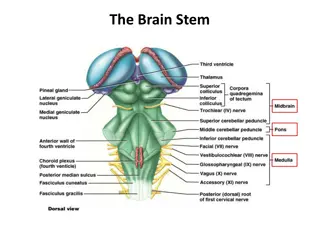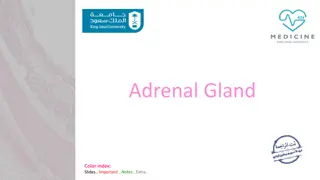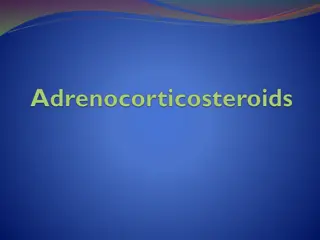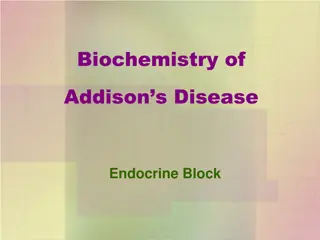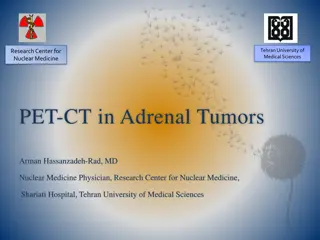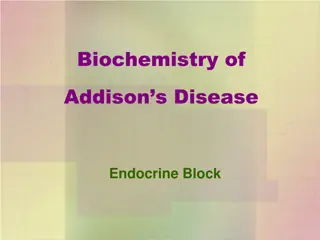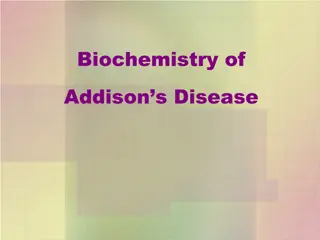
Role of Adrenal Medulla in Stress Response
Explore the function of the adrenal medulla in the body's stress response system, including the secretion of catecholamines and their effects on various physiological processes. Learn about the fight or flight response and how these hormones prepare the body for stressful situations.
Uploaded on | 0 Views
Download Presentation

Please find below an Image/Link to download the presentation.
The content on the website is provided AS IS for your information and personal use only. It may not be sold, licensed, or shared on other websites without obtaining consent from the author. If you encounter any issues during the download, it is possible that the publisher has removed the file from their server.
You are allowed to download the files provided on this website for personal or commercial use, subject to the condition that they are used lawfully. All files are the property of their respective owners.
The content on the website is provided AS IS for your information and personal use only. It may not be sold, licensed, or shared on other websites without obtaining consent from the author.
E N D
Presentation Transcript
Learning outcomes After reviewing the PowerPoint presentation, lecture notes and associated material, the student should be able to: Summarize the actions of adrenal androgens. Describe the causes and major manifestations of hyperadrenocorticism and Hypoadrenocorticism Describe circumstances in which catecholamines are released from the adrenal gland. List the major actions of catecholamines.
Adrenal medulla The adrenal medulla is the inner part or core of each adrenal gland. It is considered as part of sympathetic nervous system. It secretes catecholamines: -Adrenaline (epinephrine) -- 80% of the secretion. -Noradrenaline (norepinephrine)-- 20 % of the secretion. -small amount of dopamine They are released from chromaffin cells
of the sympathetic system . The adrenal medulla is, functionally , integral part 80% of its secretion is Epinephrine ( EP) and 20% of its secretion is Norepinephrine (NE ). EP in the bloodstream comes solely from the adrenal medulla NE in blood comes from BOTH adrenal medulla and postganglionic sympathetic nerves This is because postganglionic sympathetic nerves can not synthesize EP from its precursor NE , because they lack the enzyme ( PNMT) needed for conversion of NE into EP .
Adrenal medulla Secretion of these hormones causes: Blood to be diverted to the brain, heart, and skeletal muscle Epinephrine is the more potent stimulator of the heart and metabolic activities Norepinephrine is more influential on peripheral vasoconstriction and blood pressure
Role of the adrenal medullary hormones 1. Enhance the effects of the sympathetic nervous system. 2. Prepare the body for a stressful event. The response is known as the fight or flight response.
Effects of Catecholamines 1- Glycogenolysis in liver and skeletal muscle (can lead to hyperglycemia) which increases blood glucose level 2- Increase heart rate and blood pressure 3- Cause vasoconstriction of blood vessels 4- Mobilization of free fatty acids 5- Increase metabolic rate 6- Increase O2 consumption
Actions of adrenal medullary hormones The effects of the adrenal medullary hormones underlie the role of these hormones in preparation of body for fight or flight. The overall effect is to ensue that all requirements for increased muscle activity are available. What are these?
Control of secretion of adrenal medullary hormones The adrenal medulla is innervated by the sympathetic nervous system. Adrenal hormones are released from the medulla in response to signals from the sympathetic nervous system. The sympathetic nervous system is activated in response to stress also know as the fight or flight response. Stress can be physical (exercise), physiological (hypoglycemia, hemmorhage), or emotional, Cortisol, when secreted from the adrenal cortex in response to stress, causes release of these hormones from the medulla.
A case study? James a 35-year-old husband and father of three children, has been experiencing headaches and palpitations of increasing frequency and severity over the past six months. In addition, he has had periods of intense anxiety and panic attacks.
Pheochromocytoma Pheochromocytoma is a tumor of adrenal medulla . derived from chromaffin cells (arise from neural crest). Most often occurs in middle age. It can be life threatening if not recognized & not treated. Most tumors secrete epinephrine, NE, and dopamine and can cause episodic hypertension. Associated with neurofibromatosis.
Signs and Symptoms of Pheochromocytoma resistant hypertension (95%) headache sweating palpitations chest pain anxiety glucose intolerance increased metabolic rate classic triad
Pheochromocytoma Urinary vanillylmandelic acid, VMA breakdown products of norepinephrine) and Metanephrines: (a Plasma catecholamines: Treatment is surgical resection

